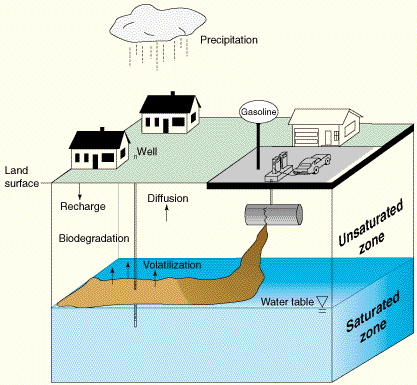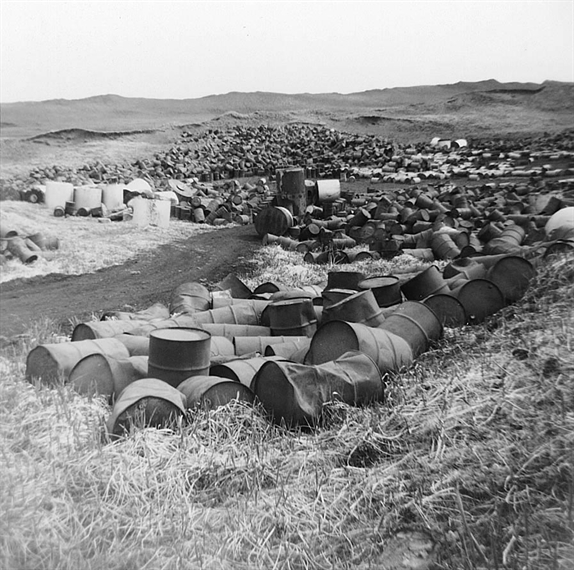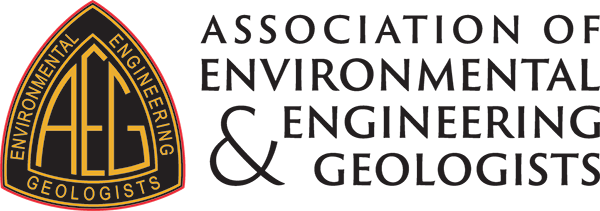Environmental Geology
 The products and chemicals we use in our daily lives sometimes make their way into our soil and water and can adversely affect the health of people and wildlife. If the underground storage tanks at corner gas stations leak or if the local dry cleaners spill the solvents used to clean clothes, these chemicals can move through the soil to ground water, potentially polluting drinking water or allowing toxic vapor to enter basements and buildings. The products and chemicals we use in our daily lives sometimes make their way into our soil and water and can adversely affect the health of people and wildlife. If the underground storage tanks at corner gas stations leak or if the local dry cleaners spill the solvents used to clean clothes, these chemicals can move through the soil to ground water, potentially polluting drinking water or allowing toxic vapor to enter basements and buildings.
An environmental geologist knows how to look at the underlying soil and rock, understands how the ground water moves, and figures out where those chemicals have gone to help find the best way to clean up the spill. County, state, and/or federal regulatory agencies require that reports documenting the geology, ground water, and contamination of such areas be submitted.

 Now communities properly site and design landfills, but what if your community used an old gravel pit as its garbage dump many years ago and now the garbage is polluting the ground water and threatening the community drinking water supply? An environmental geologist can figure out how far the contaminated ground water plume has moved through the earth and pick the best location for wells to control the contamination and prevent further degradation of the environment. Meanwhile, an environmental geologist (or engineering geologist) can help find the best location for the new landfill, placed in a geologic setting with the lowest risk of polluting ground water. Environmental geologists are also called upon to evaluate the migration of landfill gas that is generated in solid waste landfills as it decomposes. They help assure that unsafe or explosive levels of methane do not migrate off the landfill property and into nearby homes. Now communities properly site and design landfills, but what if your community used an old gravel pit as its garbage dump many years ago and now the garbage is polluting the ground water and threatening the community drinking water supply? An environmental geologist can figure out how far the contaminated ground water plume has moved through the earth and pick the best location for wells to control the contamination and prevent further degradation of the environment. Meanwhile, an environmental geologist (or engineering geologist) can help find the best location for the new landfill, placed in a geologic setting with the lowest risk of polluting ground water. Environmental geologists are also called upon to evaluate the migration of landfill gas that is generated in solid waste landfills as it decomposes. They help assure that unsafe or explosive levels of methane do not migrate off the landfill property and into nearby homes.

 Unfortunately, homes and schools were sometimes built on old military and chemical facilities before our society had a good understanding of the impacts of poor chemical disposal practices. At locations like Love Canal where homes were built on past chemical disposal sites, people became sick from exposure to ground water and soil contamination. Our understanding of these risks led to a Federal program called Superfund. Over 1,200 military bases, industrial facilities, and mine sites in the United States are being cleaned up using public tax dollars or by the landowners. Federal and State governments tightly regulate these activities and require qualified professionals to perform investigations and submit reports. Environmental geologists (and hydrogeologists) contribute knowledge of the subsurface soil and rock permeability, ground water movement, where contamination has moved, and characterize subsurface conditions that will determine how to remove and control chemicals to meet a safe level of risk. This allows “Brownfield” sites to be redeveloped and made productive to communities in a safe manner. Unfortunately, homes and schools were sometimes built on old military and chemical facilities before our society had a good understanding of the impacts of poor chemical disposal practices. At locations like Love Canal where homes were built on past chemical disposal sites, people became sick from exposure to ground water and soil contamination. Our understanding of these risks led to a Federal program called Superfund. Over 1,200 military bases, industrial facilities, and mine sites in the United States are being cleaned up using public tax dollars or by the landowners. Federal and State governments tightly regulate these activities and require qualified professionals to perform investigations and submit reports. Environmental geologists (and hydrogeologists) contribute knowledge of the subsurface soil and rock permeability, ground water movement, where contamination has moved, and characterize subsurface conditions that will determine how to remove and control chemicals to meet a safe level of risk. This allows “Brownfield” sites to be redeveloped and made productive to communities in a safe manner.

 Old mine sites are often historic and popular places to visit but can have hidden and not so hidden dangers. Open mine shafts and tunnels, poisonous gases, acid mine drainage and heavy metals in mine tailings can pose serious health and safety hazards. Some of these old mines have been listed as Superfund sites. Environmental geologists (as well as engineering geologists and hydrogeologists) use their knowledge of geology, chemistry, and ground water movement to mitigate and clean up these sites. Before a new mine is started, an environmental geologist is part of a team to help plan where to put the tailings, how to control and treat ground water, and develop a soil and water monitoring plan to show that soil and water quality goals are being met. Old mine sites are often historic and popular places to visit but can have hidden and not so hidden dangers. Open mine shafts and tunnels, poisonous gases, acid mine drainage and heavy metals in mine tailings can pose serious health and safety hazards. Some of these old mines have been listed as Superfund sites. Environmental geologists (as well as engineering geologists and hydrogeologists) use their knowledge of geology, chemistry, and ground water movement to mitigate and clean up these sites. Before a new mine is started, an environmental geologist is part of a team to help plan where to put the tailings, how to control and treat ground water, and develop a soil and water monitoring plan to show that soil and water quality goals are being met.

 Environmental geologists help prevent and repair damage to our nation’s wetlands, streams, rivers, and shorelines. Environmental geologists also help create new wetlands and stream channels to replace those lost to development. Healthy streams and rivers support endangered salmon and other wildlife. Healthy wetlands prevent contaminated storm water from directly entering our waterways and improve water quality by removing sediment and pollutants. Environmental geologists contribute knowledge of how rivers erode and deposit sediment, how stream channels migrate, and how surface water and ground water interact. Combining this knowledge with shorelines, streams, and wetland management can reduce erosion, provide stable stream channels, shorelines, and clean water for people and wildlife. People and wildlife benefit! Environmental geologists help prevent and repair damage to our nation’s wetlands, streams, rivers, and shorelines. Environmental geologists also help create new wetlands and stream channels to replace those lost to development. Healthy streams and rivers support endangered salmon and other wildlife. Healthy wetlands prevent contaminated storm water from directly entering our waterways and improve water quality by removing sediment and pollutants. Environmental geologists contribute knowledge of how rivers erode and deposit sediment, how stream channels migrate, and how surface water and ground water interact. Combining this knowledge with shorelines, streams, and wetland management can reduce erosion, provide stable stream channels, shorelines, and clean water for people and wildlife. People and wildlife benefit!
For proposed land development and infrastructure projects, environmental (and engineering) geologists assess the affects of the project on the geologic environment and the potential impacts to the project from geologic conditions and hazards at the project site.
Your community may have a disaster response plan for earthquakes, volcanic eruptions, floods, tsunamis, or hazardous chemical spills. (We hope so!) An environmental geologist can use geologic information in the planning process to identify areas of relative risk, safe evacuation routes, and recovery actions.
Association of Environmental & Engineering Geologists Role
AEG is devoted to developing professional responsibility on the part of environmental geologists, engineering geologists, and hydrogeologists. AEG provides technical and professional short courses, seminars, and technical meetings. AEG’s members contribute to public safety and provide public information and education through its website and member participation in their communities. AEG supports students in the fields of applied geology so that they develop strong technical backgrounds. AEG seeks to maintain high professional standards and enhance awareness of the responsibility of environmental geologists, engineering geologists, and hydrogeologists to the public in general.
|

 The products and chemicals we use in our daily lives sometimes make their way into our soil and water and can adversely affect the health of people and wildlife. If the underground storage tanks at corner gas stations leak or if the local dry cleaners spill the solvents used to clean clothes, these chemicals can move through the soil to ground water, potentially polluting drinking water or allowing toxic vapor to enter basements and buildings.
The products and chemicals we use in our daily lives sometimes make their way into our soil and water and can adversely affect the health of people and wildlife. If the underground storage tanks at corner gas stations leak or if the local dry cleaners spill the solvents used to clean clothes, these chemicals can move through the soil to ground water, potentially polluting drinking water or allowing toxic vapor to enter basements and buildings.
 Now communities properly site and design landfills, but what if your community used an old gravel pit as its garbage dump many years ago and now the garbage is polluting the ground water and threatening the community drinking water supply? An environmental geologist can figure out how far the contaminated ground water plume has moved through the earth and pick the best location for wells to control the contamination and prevent further degradation of the environment. Meanwhile, an environmental geologist (or engineering geologist) can help find the best location for the new landfill, placed in a geologic setting with the lowest risk of polluting ground water. Environmental geologists are also called upon to evaluate the migration of landfill gas that is generated in solid waste landfills as it decomposes. They help assure that unsafe or explosive levels of methane do not migrate off the landfill property and into nearby homes.
Now communities properly site and design landfills, but what if your community used an old gravel pit as its garbage dump many years ago and now the garbage is polluting the ground water and threatening the community drinking water supply? An environmental geologist can figure out how far the contaminated ground water plume has moved through the earth and pick the best location for wells to control the contamination and prevent further degradation of the environment. Meanwhile, an environmental geologist (or engineering geologist) can help find the best location for the new landfill, placed in a geologic setting with the lowest risk of polluting ground water. Environmental geologists are also called upon to evaluate the migration of landfill gas that is generated in solid waste landfills as it decomposes. They help assure that unsafe or explosive levels of methane do not migrate off the landfill property and into nearby homes.
 Unfortunately, homes and schools were sometimes built on old military and chemical facilities before our society had a good understanding of the impacts of poor chemical disposal practices. At locations like Love Canal where homes were built on past chemical disposal sites, people became sick from exposure to ground water and soil contamination. Our understanding of these risks led to a Federal program called Superfund. Over 1,200 military bases, industrial facilities, and mine sites in the United States are being cleaned up using public tax dollars or by the landowners. Federal and State governments tightly regulate these activities and require qualified professionals to perform investigations and submit reports. Environmental geologists (and hydrogeologists) contribute knowledge of the subsurface soil and rock permeability, ground water movement, where contamination has moved, and characterize subsurface conditions that will determine how to remove and control chemicals to meet a safe level of risk. This allows “Brownfield” sites to be redeveloped and made productive to communities in a safe manner.
Unfortunately, homes and schools were sometimes built on old military and chemical facilities before our society had a good understanding of the impacts of poor chemical disposal practices. At locations like Love Canal where homes were built on past chemical disposal sites, people became sick from exposure to ground water and soil contamination. Our understanding of these risks led to a Federal program called Superfund. Over 1,200 military bases, industrial facilities, and mine sites in the United States are being cleaned up using public tax dollars or by the landowners. Federal and State governments tightly regulate these activities and require qualified professionals to perform investigations and submit reports. Environmental geologists (and hydrogeologists) contribute knowledge of the subsurface soil and rock permeability, ground water movement, where contamination has moved, and characterize subsurface conditions that will determine how to remove and control chemicals to meet a safe level of risk. This allows “Brownfield” sites to be redeveloped and made productive to communities in a safe manner.
 Old mine sites are often historic and popular places to visit but can have hidden and not so hidden dangers. Open mine shafts and tunnels, poisonous gases, acid mine drainage and heavy metals in mine tailings can pose serious health and safety hazards. Some of these old mines have been listed as Superfund sites. Environmental geologists (as well as engineering geologists and hydrogeologists) use their knowledge of geology, chemistry, and ground water movement to mitigate and clean up these sites. Before a new mine is started, an environmental geologist is part of a team to help plan where to put the tailings, how to control and treat ground water, and develop a soil and water monitoring plan to show that soil and water quality goals are being met.
Old mine sites are often historic and popular places to visit but can have hidden and not so hidden dangers. Open mine shafts and tunnels, poisonous gases, acid mine drainage and heavy metals in mine tailings can pose serious health and safety hazards. Some of these old mines have been listed as Superfund sites. Environmental geologists (as well as engineering geologists and hydrogeologists) use their knowledge of geology, chemistry, and ground water movement to mitigate and clean up these sites. Before a new mine is started, an environmental geologist is part of a team to help plan where to put the tailings, how to control and treat ground water, and develop a soil and water monitoring plan to show that soil and water quality goals are being met.
 Environmental geologists help prevent and repair damage to our nation’s wetlands, streams, rivers, and shorelines. Environmental geologists also help create new wetlands and stream channels to replace those lost to development. Healthy streams and rivers support endangered salmon and other wildlife. Healthy wetlands prevent contaminated storm water from directly entering our waterways and improve water quality by removing sediment and pollutants. Environmental geologists contribute knowledge of how rivers erode and deposit sediment, how stream channels migrate, and how surface water and ground water interact. Combining this knowledge with shorelines, streams, and wetland management can reduce erosion, provide stable stream channels, shorelines, and clean water for people and wildlife. People and wildlife benefit!
Environmental geologists help prevent and repair damage to our nation’s wetlands, streams, rivers, and shorelines. Environmental geologists also help create new wetlands and stream channels to replace those lost to development. Healthy streams and rivers support endangered salmon and other wildlife. Healthy wetlands prevent contaminated storm water from directly entering our waterways and improve water quality by removing sediment and pollutants. Environmental geologists contribute knowledge of how rivers erode and deposit sediment, how stream channels migrate, and how surface water and ground water interact. Combining this knowledge with shorelines, streams, and wetland management can reduce erosion, provide stable stream channels, shorelines, and clean water for people and wildlife. People and wildlife benefit!